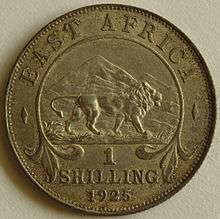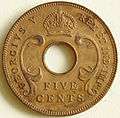East African shilling
| East African shilling | |
|---|---|
| Central bank | East African Currency Board |
| User(s) |
All in the 1900s:
|
| Superunit | |
| 20 | pound |
| Subunit | |
| 1/100 | cent |
| Coins | 1, 5, 10, 50 cents,1 shilling |
| Banknotes | 5, 10, 20, 100 shillings |
The East African shilling was the currency issued for use in British controlled areas in East Africa from 1921 until 1969.[1] It was produced by the East African Currency Board. It is also the proposed name for a common currency that the East African Community plans to introduce.

History
First East African shilling
The pound sterling was originally divided into twenty shillings, and it is normal to consider the shilling sterling to be a subsidiary unit of the pound. However, in British East Africa, even though twenty shillings were equal in value to one pound sterling, the shilling was always taken to be the primary unit of account. This state of affairs was unique amongst all the parts of the British Empire that used the sterling currency.
This anomalous state of affairs arose because British East Africa was actually originally in the rupee zone and not in the sterling zone. The East African shilling was introduced to Kenya, Tanganyika (now mainland Tanzania), and Uganda in 1921, replacing the short-lived florin at a rate of 2 shillings = 1 florin. The short lived Florin had been brought about as a result of the rising price of silver which occurred in the wake of World War I. At that time, the Indian Rupee was the currency of the British East African states. The Rupee, being a silver coin rose in value against sterling. When it reached the value of two shillings, the authorities decided to replace it with the Florin. From the florin thence came the East African shilling. The currency remained pegged to one shilling sterling and was subdivided into 100 cents.[2][3][4] In 1936, Zanzibar joined the currency board, and the Zanzibari rupee was replaced at a rate of 1.5 East African shillings = 1 Zanzibari rupee.[3] It was replaced by local currencies (Kenyan shilling, Ugandan shilling and Tanzanian shilingi) following the territories' independence.[2][3][4]
In 1951, the East African shilling replaced the Indian Rupee in the Aden colony and protectorate, which became the South Arabian Federation in 1963. In 1965, the East African Currency Board was breaking up, and the South Arabian dinar replaced the shilling in the South Arabian Federation at a rate of 20 shillings to 1 dinar.[1][5]
The shilling was also used in parts of what is now Somalia, Ethiopia and Eritrea when they were under British control. Before 1941, these areas, then known as Italian East Africa were using the Italian East African lira. In 1941, as a result of World War II, Britain regained control and introduced the shilling, at a rate of 1 shilling to 24 lira. Italian Somaliland was returned to Italy in 1949 as a UN Trusteeship and soon switched to the Italian Somaliland somalo, which was at par with the shilling. British Somaliland gained independence in 1960, and joined what had been Italian Somaliland to create Somalia. In that year Somalia began using the Somali shilling (replacing the Somali somalo) at par with the East African shilling.[6] The East African shilling ceased to be legal tender in Somalia during 1961. Ethiopia regained independence in 1941, with British support and began using the East African shilling. Maria Theresa Thalers, Indian rupees, and Egyptian pound were also legal tender at the beginning of this time, and it is unclear exactly when this status ended. Full sovereignty was restored in late 1944, and the Ethiopian birr was reintroduced in 1945 at a rate of 1 birr = 2 shillings.[7] Eritrea was captured from the Italians in 1941, and began using the East African shilling, as well as the Egyptian pound, with the lira demonetized in 1942. When Eritrea formed a federation with Ethiopia in 1952, the birr, which was already in use in Ethiopia, was adopted in Eritrea.[8]
For a wider history surrounding currency in the region, see The History of British Currency in the Middle East.
Second East African shilling
A new version of the currency is proposed by the East African Community, which consists of Kenya, Tanzania, Uganda, Rwanda, and Burundi.
Previously, it was estimated that the Second East African shilling would be introduced into circulation in 2012 but the studies that are currently guiding the process propose 2015.
Coins
Issued during the reign of George V
| Issued during the reign of George V | ||||||||
|---|---|---|---|---|---|---|---|---|
| Image | Value | Catalog number | Technical parameters | Description | Dates | Remarks | ||
| Mass | Composition | Obverse | Reverse | |||||
| 1 cent | KM 22 | Bronze | "GEORGIVS V", "REX ET IND:IMP:", crown, value | "EAST AFRICA", value, date | 1922-1935 | central hole | ||
| 5 cents | KM 18 | 1921-1936 | ||||||
| 10 cents | KM 19 | |||||||
| 50 cents ½ shilling |
KM 20 | 3.8879g | 25% silver | "GEORGIVS V", "REX ET IND:IMP:", bust of George V | Dual value, "EAST AFRICA", lion in front of mountain, date | 1921-1924 | ||
| 1 shilling | KM 21 | 7.7759g | Value, "EAST AFRICA", lion in front of mountain, date | 1921-1925 | ||||
| For table standards, see the coin specification table. | ||||||||
Issued during the reign of Edward VIII
Issued during the reign of George VI
As GEORGIVS VI
As GEORGIVS SEXTVS
| Issued during the reign of George VI as GEORGIVS SEXTVS | ||||||||
|---|---|---|---|---|---|---|---|---|
| Image | Value | Catalog number | Composition | Description | Dates | Remarks | ||
| Obverse | Reverse | |||||||
| 1 cent | KM 32 | Bronze | "GEORGIVS SEXTVS REX", crown, value | "EAST AFRICA", value, date | 1949-1952 | central hole | ||
| 5 cents | KM 33 | 1949-1952 | ||||||
| 10 cents | KM 34 | 1949-1952 | ||||||
| 50 cents ½ shilling |
KM 30 | Cupronickel | "GEORGIVS SEXTVS REX", bust of George VI | Dual value, "EAST AFRICA", lion in front of mountain, date | 1948-1952 | |||
| 1 shilling | KM 31 | Value, "EAST AFRICA", lion in front of mountain, date | 1948-1952 | |||||
| For table standards, see the coin specification table. | ||||||||
Issued during the reign of Elizabeth II
Issued after independence
Krause, Chester L., and Clifford Mishler (2003). 2004 Standard Catalog of World Coins: 1901–Present. Colin R. Bruce II (senior editor) (31st ed.). Krause Publications. ISBN 0873495934.
Banknotes
In 1921, notes were issued by the East African Currency Board in denominations of 5, 10, 20, 100, 200, 1,000 and 10,000 shillings, with the notes of 20 shillings and above also carrying the denominations given in pounds Sterling (£1, £5, £10, £50 and £500). In 1943, 1 shilling notes were issued, the only occasion that such notes were produced. 1,000 shilling notes were only issued until 1933, with 10,000 shillings notes last issued in 1947. The remaining denominations were issued until 1964.
Gallery
-

1925 East African 1 Shilling coin obverse
-

1925 East African 1 Shilling coin reverse
-

1935 East African 5 cent coin obverse
-

1935 East African 5 cent coin reverse
-

1930 East African 1 cent coin obverse
-

1930 East African 1 cent coin reverse
-

British East Africa 1 cent and 10 cent coins
References
- 1 2 "Global Financial Data currency histories table". Retrieved 2007-04-27.
- 1 2 Schuler, Kurt. "Tables of Modern Monetary History: Kenya". Retrieved 2007-04-27.
- 1 2 3 Schuler, Kurt. "Tables of Modern Monetary History: Tanzania". Retrieved 2007-05-28.
- 1 2 Schuler, Kurt. "Tables of Modern Monetary History: Uganda". Retrieved 2007-04-27.
- ↑ Schuler, Kurt. "Tables of Modern Monetary History: Asia". Retrieved 2007-04-27.
- ↑ Schuler, Kurt. "Tables of Modern Monetary History: Somalia". Retrieved 2007-04-29.
- ↑ Schuler, Kurt. "Tables of Modern Monetary History: Ethiopia". Retrieved 2007-04-29.
- ↑ Schuler, Kurt. "Tables of Modern Monetary History: Eritrea". Retrieved 2007-04-29.
- Krause, Chester L., and Clifford Mishler (1991). Standard Catalog of World Coins: 1801–1991 (18th ed.). Krause Publications. ISBN 0873411501.
- Pick, Albert (1994). Standard Catalog of World Paper Money: General Issues. Colin R. Bruce II and Neil Shafer (editors) (7th ed.). Krause Publications. ISBN 0-87341-207-9.
The last issued 10,000 shilling note was dated 1 August 1951 but the high denomination note was used for clearing internally for many years after 1951.
External links
| Preceded by: Indian rupee, Maria Theresa Thaler and other foreign currencies Ratio: 1 shilling = 1 British shilling |
Currency of Colony of Aden 1951 – 1963 |
Currency of Federation of South Arabia 1963 – 1965 |
Succeeded by: South Yemeni dinar Ratio: 1 dinar = 20 shillings = 1 British pound | |
| Currency of Aden Protectorate 1951 – 1959 |
Currency of Federation of Arab Emirates of the South 1959 – 1963 | |||
| Currency of remainder of Aden Protectorate 1959 – 1963 Note: throughout this time period, various states within the protectorate joined the federation |
Currency of Protectorate of South Arabia 1963 – 1965 | |||
| Preceded by: Zanzibari rupee Ratio: 1.5 East African shillings = 1 Zanzibari rupee = 1 Indian rupee = 1.5 British shilling |
Currency of Zanzibar January 1, 1936 – 1964 |
Currency of Tanzania (formerly Tanganyika and Zanzibar) 1964 – 1969 |
Succeeded by: Tanzanian shilingi Reason: currency independence Ratio: at par Note: independent shilling introduced in 1966, but EA shilling not demonetized until 1969 | |
| Preceded by: East African florin Ratio: 2 shillings = 1 florin = 2 British shilling |
Currency of East Africa (Kenya, Tanganyika, Uganda) 1921 – various dates of independence | |||
| Currency of Kenya 1963 – 1969 |
Succeeded by: Kenyan shilling Reason: currency independence Ratio: at par Note: independent shilling introduced in 1966, but EA shilling not demonetized until 1969 | |||
| Currency of Uganda 1962 – 1969 |
Succeeded by: First Ugandan shilling Reason: currency independence Ratio: at par Note: independent shilling introduced in 1966, but EA shilling not demonetized until 1969 | |||
| Preceded by: Italian East African lira Reason: United Kingdom recaptured British Somaliland from Italy, and also occupied Italian East Africa Ratio: 1 shilling = 24 lira = 1 British shilling |
Currency of British Somaliland 1941 – 1962 |
Succeeded by: Somali shilling Reason: independence as part of Somalia Ratio: at par | ||
| Currency of Italian Somaliland 1941 – 1950 |
Succeeded by: Italian Somaliland somalo Reason: return to Italy (in 1949) Ratio: at par | |||
| Currency of Ethiopia 1941 – 1945 |
Succeeded by: Ethiopian birr Reason: (Ethiopia) independence (Eritrea) federation with Ethiopia Ratio: 1 birr = 2 shillings | |||
| Currency of Eritrea 1941 – 1952 | ||||